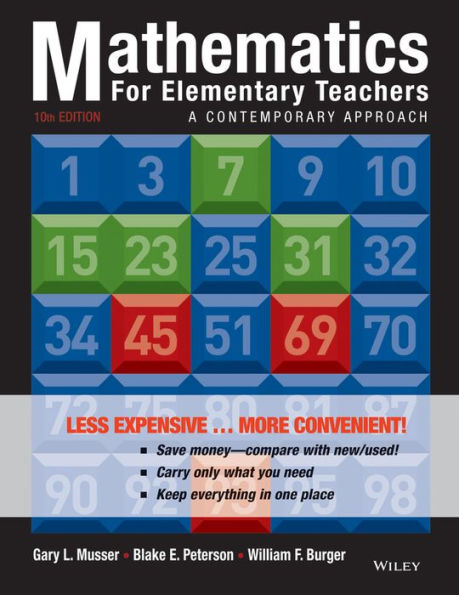Table of Contents
Preface xi
1 Introduction to Problem Solving 2
1.1 The Problem-Solving Process and Strategies 5
1.2 Three Additional Strategies 21
2 Sets, Whole Numbers, and Numeration 42
2.1 Sets as a Basis for Whole Numbers 45
2.2 Whole Numbers and Numeration 57
2.3 The Hindu–Arabic System 67
3 Whole Numbers: Operations and Properties 84
3.1 Addition and Subtraction 87
3.2 Multiplication and Division 101
3.3 Ordering and Exponents 116
4 Whole Number Computation—Mental, Electronic, and Written 128
4.1 Mental Math, Estimation, and Calculators 131
4.2 Written Algorithms for Whole-Number Operations 145
4.3 Algorithms in Other Bases 162
5 Number Theory 174
5.1 Primes, Composites, and Tests for Divisibility 177
5.2 Counting Factors, Greatest Common Factor, and Least Common Multiple 190
6 Fractions 206
6.1 The Set of Fractions 209
6.2 Fractions: Addition and Subtraction 223
6.3 Fractions: Multiplication and Division 233
7 Decimals, Ratio, Proportion, and Percent 250
7.1 Decimals 253
7.2 Operations with Decimals 262
7.3 Ratio and Proportion 274
7.4 Percent 283
8 Integers 302
8.1 Addition and Subtraction 305
8.2 Multiplication, Division, and Order 318
9 Rational Numbers, Real Numbers, and Algebra 338
9.1 The Rational Numbers 341
9.2 The Real Numbers 358
9.3 Relations and Functions 375
9.4 Functions and Their Graphs 391
10 Statistics 412
10.1 Statistical Problem Solving 415
10.2 Analyze and Interpret Data 440
10.3 Misleading Graphs and Statistics 460
11 Probability 484
11.1 Probability and Simple Experiments 487
11.2 Probability and Complex Experiments 502
11.3 Additional Counting Techniques 518
11.4 Simulation, Expected Value, Odds, and Conditional Probability 528
12 Geometric Shapes 546
12.1 Recognizing Geometric Shapes—Level 0 549
12.2 Analyzing Geometric Shapes—Level 1 564
12.3 Relationships between Geometric Shapes—Level 2 579
12.4 An Introduction to a Formal Approach to Geometry 589
12.5 Regular Polygons, Tessellations, and Circles 605
12.6 Describing Three-Dimensional Shapes 620
13 Measurement 644
13.1 Measurement with Nonstandard and Standard Units 647
13.2 Length and Area 665
13.3 Surface Area 686
13.4 Volume 696
14 Geometry Using Triangle Congruence and Similarity 716
14.1 Congruence of Triangles 719
14.2 Similarity of Triangles 729
14.3 Basic Euclidean Constructions 742
14.4 Additional Euclidean Constructions 755
14.5 Geometric Problem Solving Using Triangle Congruence and Similarity 765
15 Geometry Using Coordinates 780
15.1 Distance and Slope in the Coordinate Plane 783
15.2 Equations and Coordinates 795
15.3 Geometric Problem Solving Using Coordinates 807
16 Geometry Using Transformations 820
16.1 Transformations 823
16.2 Congruence and Similarity Using Transformations 846
16.3 Geometric Problem Solving Using Transformations 863
Epilogue: An Eclectic Approach to Geometry 877
Topic 1. Elementary Logic 881
Topic 2. Clock Arithmetic: A Mathematical System 891
Answers to Exercise/Problem Sets A and B, Chapter Reviews, Chapter Tests, and Topics Section A1
Index i1
Contents of Book Companion Web Site
Resources for Technology Problems
eManipulatives
Spreadsheet Activities
Geometer’s Sketchpad Activities
Technology Tutorials
Spreadsheets
Geometer’s Sketchpad
Programming in Logo
Graphing Calculators
Webmodules
Algebraic Reasoning
Children’s Literature
Introduction to Graph Theory
Additional Resources
Guide to Problem Solving
Problems for Writing/Discussion
Research Articles
Web Links
Videos
Book Overview
Author Walk-Through Videos
Children’s Videos







